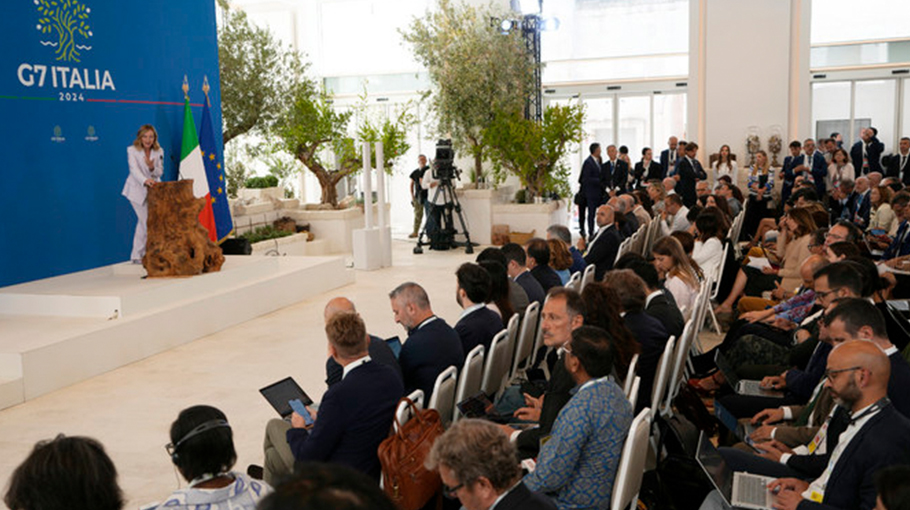G7 steps up as geopolitics defines Italy’s summit

The G7 was created amid the instability of the 1970s to monitor developments in the world economy. Yet, its role as a geopolitical lynchpin has long been key to a function that has been highlighted at the Italian leadership summit this week.
Top of the agenda was Ukraine, where the situation has “deteriorated dramatically,” according to Germany’s Foreign Minister Annalena Baerbock. Ukrainian President Volodymyr Zelensky, who traveled to Italy for the summit, implored the West for urgent, increased support.
A number of security deals were made with Kyiv, the standout of which is a 10-year bilateral agreement with the US — seen in the West as a potential transition point for Ukraine on the road to joining NATO. This includes commitments for prolonged aid encompassing areas such as military training, the sharing of intelligence, and economic assistance.
The deal builds from the unexpected decision by US President Biden in recent days to bend to international pressure to allow Ukraine to use US-made weapons to hit Russian territory for the first time. This after other Western allies, including Germany and France, eased their own rules following NATO chief Jens Stoltenberg’s assertion that the “time has come” for change.
To be sure, the long-term US policy of stopping Kyiv deploying long-range missiles to strike targets inside Russia — across the board — has not been altered. Instead, the change, for now, is limited to Ukraine using US weapons for counterattack purposes in Kharkiv. Nonetheless, the shift could be significant, and a potential sign of things to come, especially if Russia makes much more ground in coming weeks.
The G7 also agreed this week to a $50 billion loan to Ukraine. This uses profits from $300 billion in frozen Russian assets in the West to boost funding for Kyiv, a move that Moscow has condemned.
There were also broader efforts at the summit to woo the Global South on Ukraine. Italian Prime Minister Georgia Meloni invited a range of key emerging market leaders, including Argentina’s President Javier Milei, Brazil’s President Luiz Inacio Lula da Silva, Turkish President Recep Tayyip Erdogan, UAE President Mohamed bin Zayed Al-Nahyan, Indian Prime Minister Narendra Modi, and South African President Cyril Ramaphosa.
Outside of Ukraine, there was significant focus on Israel, with the G7 giving strong public backing to the US ceasefire deal outlined by Biden. This calls for an immediate ceasefire in Gaza, the release of all hostages, plus a significant and sustained increase in humanitarian assistance for distribution throughout the enclave.
China was also on the agenda, with the US pushing, in the words of US Treasury Secretary Janet Yellen, for a “strategic and united” response to China’s overinvestment in electric vehicles, solar products, semiconductors, steel, and other key sectors in order to keep Western firms economically viable in these areas. The goal in Yellen’s assertion is “building a wall of opposition to the strategy that (China) is pursuing.”
This US call for G7 unity on China comes soon after the Biden team’s announcement of new tariffs on Chinese EVs, batteries, solar panels, and other products, with some of the measures due to kick in on Aug. 1. The US tariffs were added to this week by the EU’s counterpart measures against Chinese EVs. While there were many international skeptics of this week’s G7 meeting producing any meaningful outcomes, the agreements reached, including on Ukraine, may prove significant. This should not be too surprising, as the Western club has previously been at its best in times of crisis, tackling the big issues of the day.
It was founded in 1975 in the aftermath of geopolitical and economic shocks when Washington pulled out of the gold standard. This underlines that it is fit for turbulent times like today.
Back then, US President Richard Nixon had resigned, and there was a clear and imminent danger of currency wars. The G7 stepped up to the plate, however, playing a key role in the management of the most important exchange rates. It also brought Japan into the Western policymaking community, and a similar far-sighted approach is needed today to try to get greater alignment with leaders of the Global South.
So the body has a proven record of delivering, and can potentially play a significant role again now. This is especially urgent given the paralysis of the G20, with splits between the West and Russia, China plus its allies.
The Italian summit may also be noteworthy as it is potentially the last of Biden’s presidency. At the back of the mind of the leaders has been the possibility that next year’s event could see the return of former US President Donald Trump.
From 2017 to 2021, Trump’s presence prompted the worst divisions ever within the G7. This reached its nadir in 2018 at the Canadian summit, which saw an unprecedented failure to agree an end-of-summit communique and remarkable undiplomatic language, including Trump’s characterization of Canadian Prime Minister Justin Trudeau as “so indignant,” while the latter called the US leader’s trade tariffs “laughable.”
The personal animosity on display between Trump and other leaders provided political atmospherics for wider policy splits. The US leader, for instance, called on the first day of the summit for Russia to be allowed to rejoin the group (as the G8), as was the case from 1997 to 2013. Yet other G7 leaders dismissed this, and instead called for a “rapid and unified” response to Moscow’s malign international interference.
Taken together, the Italian summit has provided a key moment for Western leaders to double down on the big strategic questions facing the world. At a time when the G20 has become less effective, the G7 has assumed new relevance and has greater potential to set the global agenda again.
Andrew Hammond is an Associate at LSE IDEAS at the London School of Economics
Source: Arab News




